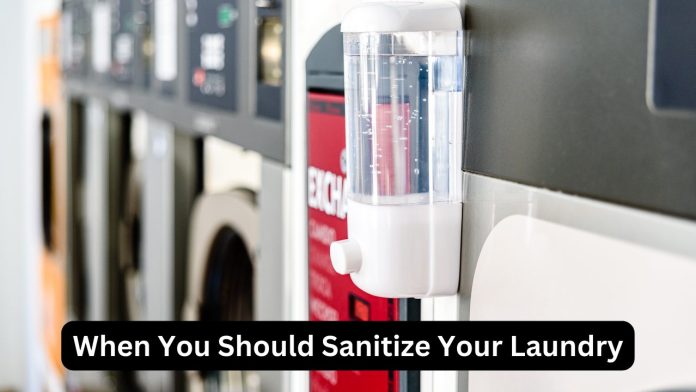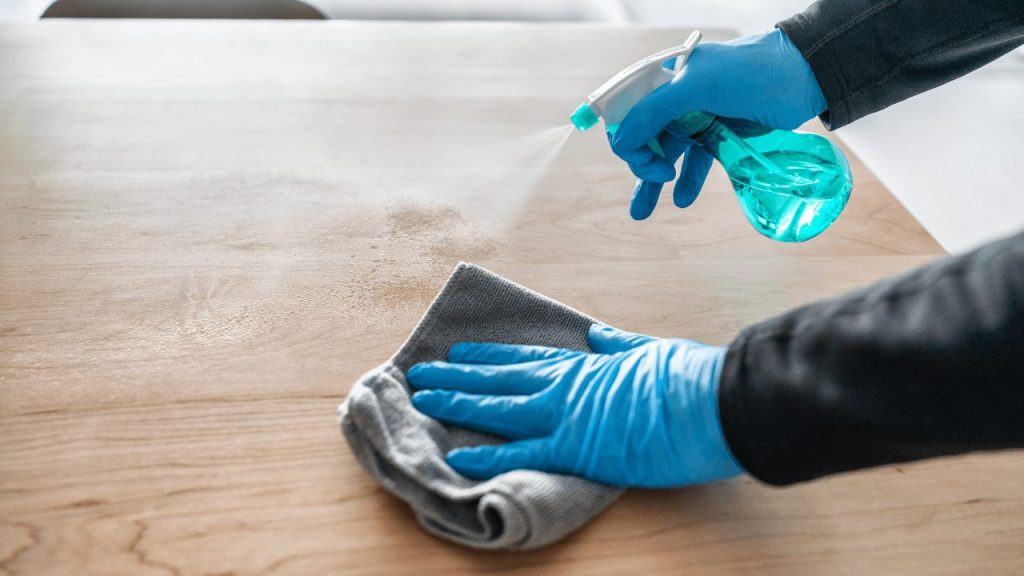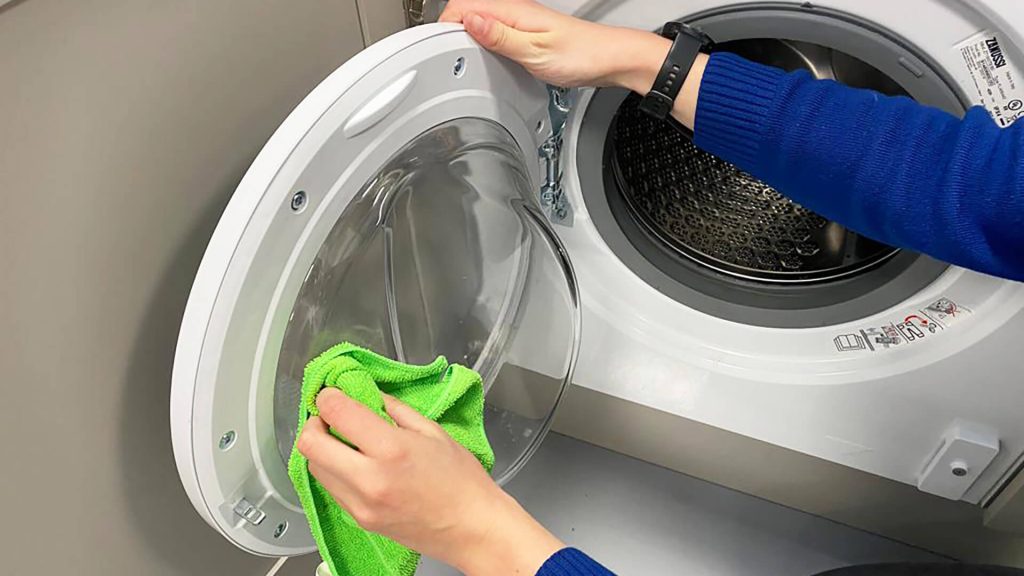Clothes play a big part in our lives. They keep us warm, make us look good, and protect us. But just because they look clean doesn’t mean they are free from tiny germs we can’t see. This brings us to an important question: When should you sanitize your laundry? Cleaning our clothes removes visible dirt and stains, but sanitizing goes one step further. It targets those hidden germs that regular washing might miss. Think of it this way: cleaning is like sweeping your house’s floors while sanitizing is like ensuring every nook and cranny is germ-free. As we dive into this topic, we’ll explore the difference between these two and find the best times to give our clothes that extra deep clean.
Everyday Exposure to Germs: Your Clothes in the Microscopic Battlefield
Every day, whether at work, at the grocery store, using public transport, or even just taking a stroll in the park, our bodies continuously dance with countless germs. From the benign to the potentially harmful, these microscopic entities are everywhere, and while our immune systems are adept at protecting us, the fabrics we wear often serve as the first line of defense.
Consider an ordinary day to picture the depth of our interaction with germs. You shake hands with a colleague, sit on a public bench, or perhaps brush against someone in a crowded place. Every touch, every interaction, introduces a possibility for germs to transfer. These aren’t always harmful; many microbes are entirely harmless or beneficial. However, the harmful ones, even in the minority, can pose risks if not addressed.
In these scenarios, our clothes act like sponges. They absorb sweat, trap skin cells, and, most importantly, collect germs from every surface they come into contact with. If you’ve ever wondered why the sleeve of your shirt or the hem of your dress gets dirtier, these areas often contact external surfaces. Over time, without proper care, our clothing can transform from mere fabric to a thriving hub for these microorganisms.
Key Moments to Consider Sanitizing
a) Illness in the Household
The environment subtly shifts when someone in the home falls ill, especially with contagious diseases. Each cough, sneeze, or touch can spread the illness-causing germs. Being in direct contact with our bodies, clothes can quickly become carriers, inadvertently helping spread these pathogens. It’s not just about the person who’s sick; it’s about the people they live with. The transfer risk is real, especially when dealing with viral infections or contagious bacteria. Sanitizing laundry in such scenarios isn’t just a precaution; it’s a necessity. It becomes paramount to ensure that what might be clinging to the fabrics – those invisible threats – are thoroughly eradicated to prevent further spread within the household.
b) Exposure to Harmful Chemicals or Contaminants
Our daily routines might sometimes lead us into areas or tasks where our clothing gets exposed to chemicals or pollutants. Maybe it’s that DIY paint job, a workshop day, or even an accidental spill of household cleaning agents. While regular cleaning might remove the stains or the evident residues, traces of these harmful substances might still linger on a microscopic level. Sanitizing is not just about germs; it’s about ensuring that any remnants of these chemicals or contaminants are comprehensively removed. This step ensures the wearer’s safety, especially for those with sensitive skin or allergies.
c) Post-gym or Heavy Physical Activity
There’s a distinct satisfaction after a good workout or intense physical activity. But with sweat and effort come bacteria that thrive in the moist environments of our gym clothes. Simply washing might rid the fabric of the sweat smell, but does it ensure the elimination of all bacteria? Not always. That’s where sanitizing steps in. It ensures that the fabric is clean to the eyes and nose and on a bacterial level. Sanitizing post-gym clothes helps keep skin infections at bay and provides a fresh start for the next workout.
d) Handling Raw Foods
Cooking is an art and a science, especially when dealing with raw foods like meat, poultry, or fish. While essential for our diets, these foods carry microbes that can easily transfer onto aprons or any clothing we wear while handling them. Imagine prepping chicken and then wiping your hands on a cloth or apron. That fabric potentially houses bacteria from the raw meat, leading to cross-contamination risks. Sanitizing after cooking or handling raw products ensures that any potential pathogens are dealt with, ensuring a safer cooking environment and peace of mind for the next culinary adventure.
Methods to Properly Sanitize Laundry
a) High-temperature washing
Heat is a formidable foe for most bacteria and germs. Many harmful microorganisms find it difficult to survive in high temperatures, making hot washing an effective sanitization technique. For those garments that can withstand hot temperatures without getting damaged, setting your washing machine to a higher temperature can be the first step towards achieving sanitized laundry. However, checking your washing machine’s manual and the care labels on your clothes is vital. Ensure you’re not exceeding recommended temperatures, which could damage your garments. Consistency is key; ensure your machine maintains the heat throughout the cycle for effective results.
b) Using Disinfectants or Sanitizers
There’s a plethora of laundry disinfectants and sanitizers available in the market. These products are designed specifically to kill bacteria and other pathogens that regular detergents might miss. When choosing one, opting for an effective and safe product for your fabrics is important. Always read the label and follow the recommended dosage – too much or too little can affect the results. Also, be cautious about potential allergic reactions, especially if you or someone in your household has sensitive skin. It’s always a good practice to test a new product on a small piece of fabric before applying it to a full load.
c) Sun-Drying Techniques
Mother Nature has her own disinfectant – the sun. The UV rays from the sun have proven sanitizing qualities. Sun-drying is not just energy-efficient but can also act as a natural sanitizer. When using this method, ensure your clothes are spread out and receive direct sunlight. Turning clothes over midway through drying ensures all parts receive ample exposure. However, be mindful of potential fabric fading, especially with darker colors. While sun-drying is an excellent natural method for sanitization, it’s best combined with other methods for maximum efficacy, especially when dealing with heavily soiled clothes or garments exposed to harmful bacteria.
Over-Sanitization: A Word of Caution
In our quest for cleanliness and peace of mind with germ-free clothing, it might be tempting to sanitize our laundry every time. However, as with many things in life, there’s such a thing as too much of a good thing when it comes to sanitizing.
Firstly, constantly exposing our clothes to high temperatures or potent sanitizers can expedite wear and tear. Think of it as constantly putting your garments under stress. Over time, this stress can cause fabrics to thin out, colors to fade, and even result in rips or tears. The elasticity of certain materials, like those in workout clothes, can also be compromised, reducing the garment’s lifespan.
Secondly, not all bacteria are harmful. Our environment and even our skin have beneficial bacteria. Over-sanitization could eliminate these friendly microbes, leading to an imbalance. This can pave the way for harmful bacteria to multiply faster since there’s less resource competition.
Moreover, frequent use of strong chemicals or disinfectants might lead to irritation, allergies, or rashes for sensitive skin. Striking a balance is always essential to ensure skin health and comfort.
Lastly, frequent sanitization can prove costly economically. The financial implications can accumulate, such as increased electricity bills due to high-temperature washes or the cost of regularly buying sanitizers.
Balancing Routine Washing with Sanitization:
In the realm of laundry, achieving a balance between routine washing and sanitization is pivotal. Just as every stain doesn’t warrant aggressive scrubbing, not every laundry load requires sanitization. Here’s how to strike that equilibrium, keeping your family’s health and your fabrics’ longevity in mind.
Recognizing Standard Washing Sufficiency
Routine activities often don’t subject our clothes to harmful bacteria or contaminants. Standard washing is often sufficient for daily wear garments like the shirt you wore to a casual outing, the pants you donned for a day at the office, or the pajamas you lounged in.
- Visual & Olfactory Checks: A regular wash cycle is typically adequate if clothes don’t have visible stains or a pronounced odor.
- Separation Strategy: Separate daily wear from clothes exposed to more demanding situations (e.g., gym wear, cooking aprons). This ensures that regular garments aren’t subjected to unnecessary sanitization processes.
Crafting a Thoughtful Laundry Routine
It’s about crafting a practical and effective routine. By categorizing your laundry and understanding the demands of each category, you can tailor your washing techniques accordingly.
- Scheduled Sanitization: Instead of sanitizing every load, set a schedule. For instance, consider sanitizing relevant garments after a family member recovers from an illness or post a heavy-duty cleaning spree in the house.
- Fabric First: Always consider the fabric type. Delicate fabrics may not withstand frequent sanitization. Ensure you’re using methods that are effective in sanitization and gentle on the fabric.
- Eco-friendly Options: Remember, every high-temperature wash consumes more energy. If you’re environmentally conscious, opt for sun drying or use eco-friendly sanitizers in regular-temperature washes.
- Rotation Strategy: If you have multiple sets of bed linens or towels, rotate them. This way, each set isn’t subjected to frequent sanitization, preserving the fabric’s integrity.
You might be interested in Sanitation Towel | Sanitary Towels Usage & Guide
FAQs
Q1: Why is it important to sanitize your laundry?
A1: Sanitizing your laundry helps to eliminate bacteria, viruses, and other pathogens that regular washing might not fully remove. This is particularly important for reducing the risk of infections, especially in households with sick family members, young children, or elderly individuals.
Q2: When should you sanitize your laundry?
A2: You should sanitize your laundry when exposed to bodily fluids, such as blood, sweat, urine, or vomit. Additionally, laundering items used by someone sick or with a compromised immune system and washing cloth diapers, athletic wear, and kitchen towels also warrant sanitation.
Q3: What are the most effective methods for sanitizing laundry?
A3: The most effective methods for sanitizing laundry include using hot water (at least 140°F), bleach, or a laundry sanitizer product. Ensuring that items are dried thoroughly, preferably in a high-heat dryer cycle, can also contribute to effective sanitization.
Q4: Can you sanitize laundry without bleach?
A4: Yes, you can sanitize laundry without bleach using laundry sanitizers containing ingredients like hydrogen peroxide or pine oil. Additionally, drying clothes in a high-heat setting and using hot water can help sanitize without bleach.
Q5: Is regular washing detergent enough to sanitize laundry?
A5: Regular washing detergent alone is typically insufficient to sanitize laundry completely. While it can remove dirt and some germs, it may not eliminate all harmful bacteria and viruses. Using hot water, bleach, or a laundry sanitizer in combination with your detergent is more effective for complete sanitation.
Conclusion
Knowing when to sanitize your laundry is as much an art as a science. It’s a delicate balance between ensuring health and maintaining the longevity of our cherished garments. Not every piece of clothing we wear warrants the rigorous procedures of sanitization, but there are undeniable moments, as highlighted throughout our discussion, where it becomes essential.
Understanding when to sanitize your laundry provides more than just clean clothes; it offers peace of mind. It assures us that we safeguard our homes from potential health threats and keep harmful bacteria at bay. Yet, it’s imperative to recognize that not every garment requires this stringent care every time. As we exercise judgment in various aspects of our lives, discernment is crucial in our laundry routines.


